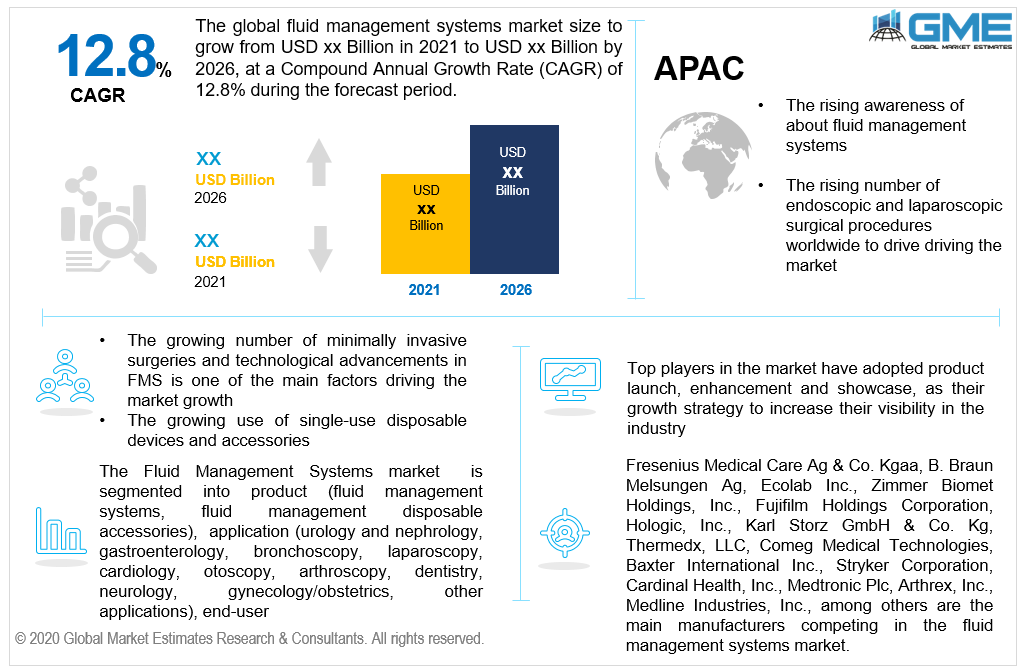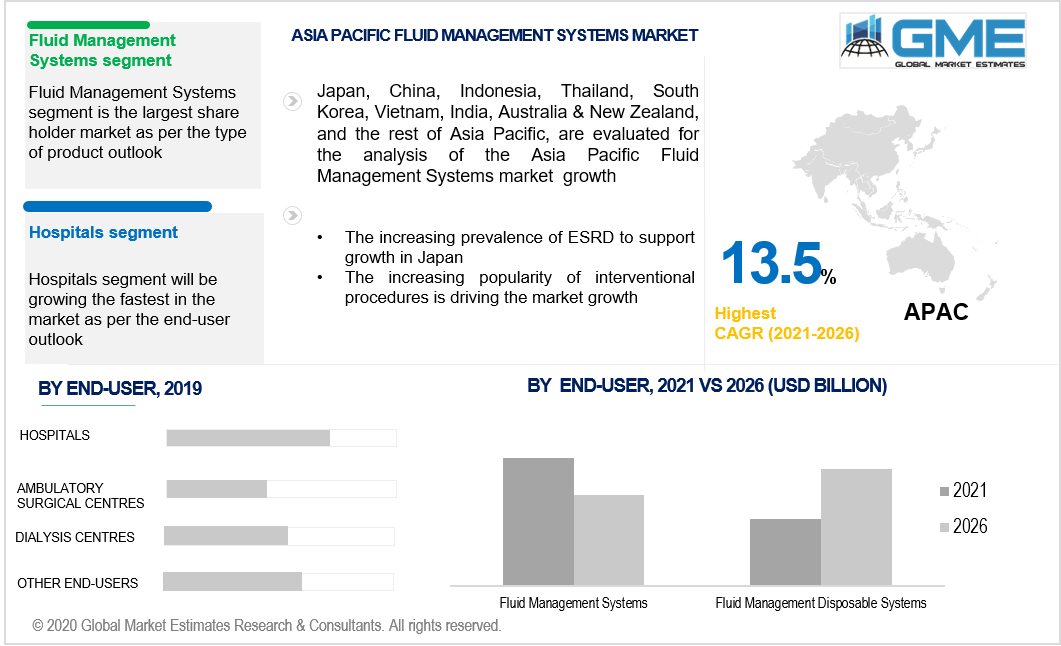
Global Fluid Management Systems Market Size, Trends, and Analysis - Forecasts To 2026 By Product (Fluid Management Systems, Fluid Management Disposable Accessories), By Application (Urology and Nephrology, Gastroenterology, Bronchoscopy, Laparoscopy, Cardiology, Otoscopy, Arthroscopy, Dentistry, Neurology, Gynecology/Obstetrics, Other Applications), By End-User (Hospitals, Ambulatory Surgical Centres, Dialysis Centres, Other End-Users), By Region (North America, Asia Pacific, CSA, Europe, and the Middle East and Africa); End-User Landscape, Company Market Share Analysis & Competitor Analysis
Fluid control systems are used to regulate body fluid, to avoid risks associated with undesirable amounts of fluid in the human body. To prevent an emergency, it is used beforehand for the detection of serious medical conditions. The system performs different functions, including fluid irrigation, control of deficits, fluid freezing, and filtration of fluids, among others. The growth of the global fluid management systems market is anticipated to propel by rising technological developments in the healthcare industry, increasing minimally invasive surgeries, and the rising government funding and worldwide grants for endo-surgical treatments. Increasing chronic disorders and increasing funding for non-surgical treatments are some of the main drivers of market growth in the coming years. Furthermore, some other factors driving the market growth are the growing prevalence of ESRD, increasing awareness of fluid control systems, and increasing patient pools.

In 2019, the fluid control systems segment is estimated to account for a significant market share. The segment is further divided into standalone systems for fluid management and integrated systems for fluid management. Standalone systems for fluid control are less costly than integrated fluid management systems. The growth of the segment of the dialyzer is mainly due to the rising occurrence of chronic kidney disease. In adults, diabetes and high blood pressure are known to be significant causes of CKD. When waste and extra water build up in the body, the dialyzer is used to purify the blood of people suffering from extreme kidney failure and can trigger other health problems.
Over the projected timeframe, the laparoscopy will exhibit a high CAGR. These seeds are mainly grown on conventional farms and are readily available. Growth is attributable to the increasing change towards minimally invasive surgical procedures in this application segment, which in turn increases the number of laparoscopic surgical procedures conducted globally. Moreover, in the coming years, the growing number of hospitals and investments in laparoscopy and endoscopy facilities are among the important factors influencing the segmental market development.
The hospital segment will expand to the highest CAGR and hold the largest market share in 2019 in terms of revenue growth. This is due to the rising number of surgical treatments in these facilities, restructuring the hospital often raises the complexity of payment procedures and increasing demand for a minimum stay in hospitals is boosting the market growth.

In terms of revenue for the coming years, the North American region holds the leading market position. The large presence of device manufacturers, technological advancement, the occurrence of a favorable scenario for reimbursement, a large patient population, and growth in the number of dialysis centers are the main drivers of this regional sector. Furthermore, the Asia-Pacific region is expected to see the fastest-growing market, attributed to the increasing healthcare infrastructure in India to support minimally invasive surgical procedures and the rising medical tourism and number of hospitals in Asian countries.
Stryker Corporation, Comeg Medical Technologies, Olympus Corporation, Fujifilm Holdings Corporation, Hologic, Inc., Baxter International Inc., Thermedx, LLC, Cardinal Health, Inc., Ecolab Inc., Medtronic Plc, Conmed Corporation, Smith & Nephew Plc, Arthrex, Inc., Karl Storz GmbH & Co. Kg, Endomed Systems GmbH, Zimmer Biomet Holdings, Inc., Medline Industries, Inc., and B. Braun Melsungen Ag, among others are the main manufacturers competing in the market.
Please note: This is not an exhaustive list of companies profiled in the report.
In December 2020, Medtronic PLC introduced its new product the Carpediem System, a neonatal acute dialysis machine and a pediatric in the U.S.
In June 2020, Fresenius Medical Care decided to establish more than 100 new centers for transitional care units (TCU) in the United States.
We value your investment and offer free customization with every report to fulfil your exact research needs.
The Global Fluid Management Systems Market has been studied from the year 2019 till 2026. However, the CAGR provided in the report is from the year 2021 to 2026. The research methodology involved three stages: Desk research, Primary research, and Analysis & Output from the entire research process.

The desk research involved a robust background study which meant referring to paid and unpaid databases to understand the market dynamics; mapping contracts from press releases; identifying the key players in the market, studying their product portfolio, competition level, annual reports/SEC filings & investor presentations; and learning the demand and supply side analysis for the Fluid Management Systems Market.

The primary research activity included telephonic conversations with more than 50 tier 1 industry consultants, distributors, and end-use product manufacturers.

Finally, based on the above thorough research process, an in-depth analysis was carried out considering the following aspects: market attractiveness, current & future market trends, market share analysis, SWOT analysis of the companies and customer analytics.

Tailor made solutions just for you
80% of our clients seek made-to-order reports. How do you want us to tailor yours?
OUR CLIENTS